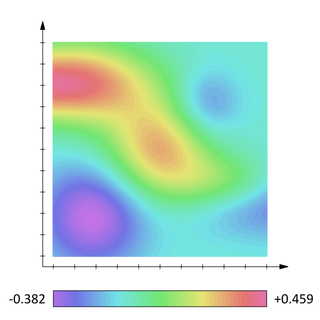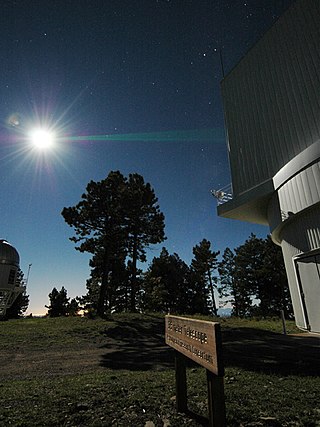Related Research Articles

In physics and general relativity, gravitational redshift is the phenomenon that electromagnetic waves or photons travelling out of a gravitational well lose energy. This loss of energy corresponds to a decrease in the wave frequency and increase in the wavelength, known more generally as a redshift. The opposite effect, in which photons gain energy when travelling into a gravitational well, is known as a gravitational blueshift. The effect was first described by Einstein in 1907, eight years before his publication of the full theory of relativity.

General relativity, also known as the general theory of relativity and Einstein's theory of gravity, is the geometric theory of gravitation published by Albert Einstein in 1915 and is the current description of gravitation in modern physics. General relativity generalises special relativity and refines Newton's law of universal gravitation, providing a unified description of gravity as a geometric property of space and time or four-dimensional spacetime. In particular, the curvature of spacetime is directly related to the energy and momentum of whatever matter and radiation are present. The relation is specified by the Einstein field equations, a system of second order partial differential equations.
The following is a timeline of gravitational physics and general relativity.

In mathematics and physics, a scalar field is a function associating a single number to every point in a space – possibly physical space. The scalar may either be a pure mathematical number (dimensionless) or a scalar physical quantity.
In physics, there are four observed fundamental interactions that form the basis of all known interactions in nature: gravitational, electromagnetic, strong nuclear, and weak nuclear forces. Some speculative theories have proposed a fifth force to explain various anomalous observations that do not fit existing theories. The characteristics of this fifth force depend on the hypothesis being advanced. Many postulate a force roughly the strength of gravity with a range of anywhere from less than a millimeter to cosmological scales. Another proposal is a new weak force mediated by W′ and Z′ bosons.

Sergei Kopeikin is a USSR-born theoretical physicist and astronomer presently living and working in the United States, where he holds the position of Professor of Physics at the University of Missouri in Columbia, Missouri. He specializes in the theoretical and experimental study of gravity and general relativity. He is also an expert in the field of the astronomical reference frames and time metrology. His general relativistic theory of the Post-Newtonian reference frames which he had worked out along with Victor A. Brumberg, was adopted in 2000 by the resolutions of the International Astronomical Union as a standard for reduction of ground-based astronomical observation. A computer program Tempo2 used to analyze radio observations of pulsars, includes several effects predicted by S. Kopeikin that are important for measuring parameters of the binary pulsars, for testing general relativity, and for detection of gravitational waves of ultra-low frequency. Sergei Kopeikin has worked out a complete post-Newtonian theory of equations of motion of N extended bodies in scalar-tensor theory of gravity with all mass and spin multipole moments of arbitrary order and derived the Lagrangian of the relativistic N-body problem.

Robert Henry Dicke was an American astronomer and physicist who made important contributions to the fields of astrophysics, atomic physics, cosmology and gravity. He was the Albert Einstein Professor in Science at Princeton University (1975–1984).

The Apache Point Observatory Lunar Laser-ranging Operation, or APOLLO, is a project at the Apache Point Observatory in New Mexico. It is an extension and advancement of previous Lunar Laser Ranging experiments, which use retroreflectors on the Moon to track changes in lunar orbital distance and motion.

In the theory of general relativity, the equivalence principle is the equivalence of gravitational and inertial mass, and Albert Einstein's observation that the gravitational "force" as experienced locally while standing on a massive body is the same as the pseudo-force experienced by an observer in a non-inertial (accelerated) frame of reference.
In physics, the Brans–Dicke theory of gravitation is a competitor to Einstein's general theory of relativity. It is an example of a scalar–tensor theory, a gravitational theory in which the gravitational interaction is mediated by a scalar field as well as the tensor field of general relativity. The gravitational constant is not presumed to be constant but instead is replaced by a scalar field which can vary from place to place and with time.

In theoretical physics, quantum field theory in curved spacetime (QFTCS) is an extension of quantum field theory from Minkowski spacetime to a general curved spacetime. This theory uses a semi-classical approach; it treats spacetime as a fixed, classical background, while giving a quantum-mechanical description of the matter and energy propagating through that spacetime. A general prediction of this theory is that particles can be created by time-dependent gravitational fields (multigraviton pair production), or by time-independent gravitational fields that contain horizons. The most famous example of the latter is the phenomenon of Hawking radiation emitted by black holes.
The Shapiro time delay effect, or gravitational time delay effect, is one of the four classic Solar System tests of general relativity. Radar signals passing near a massive object take slightly longer to travel to a target and longer to return than they would if the mass of the object were not present. The time delay is caused by spacetime dilation, which increases the time it takes light to travel a given distance from the perspective of an outside observer. In a 1964 article entitled Fourth Test of General Relativity, Shapiro wrote:
Because, according to the general theory, the speed of a light wave depends on the strength of the gravitational potential along its path, these time delays should thereby be increased by almost 2×10−4 sec when the radar pulses pass near the sun. Such a change, equivalent to 60 km in distance, could now be measured over the required path length to within about 5 to 10% with presently obtainable equipment.
Tests of general relativity serve to establish observational evidence for the theory of general relativity. The first three tests, proposed by Albert Einstein in 1915, concerned the "anomalous" precession of the perihelion of Mercury, the bending of light in gravitational fields, and the gravitational redshift. The precession of Mercury was already known; experiments showing light bending in accordance with the predictions of general relativity were performed in 1919, with increasingly precise measurements made in subsequent tests; and scientists claimed to have measured the gravitational redshift in 1925, although measurements sensitive enough to actually confirm the theory were not made until 1954. A more accurate program starting in 1959 tested general relativity in the weak gravitational field limit, severely limiting possible deviations from the theory.
An atom interferometer is an interferometer which uses the wave character of atoms. Similar to optical interferometers, atom interferometers measure the difference in phase between atomic matter waves along different paths. Today, atomic interference is typically controlled with laser beams. Atom interferometers have many uses in fundamental physics including measurements of the gravitational constant, the fine-structure constant, the universality of free fall, and have been proposed as a method to detect gravitational waves. They also have applied uses as accelerometers, rotation sensors, and gravity gradiometers.
In physics, precisely in the study of the theory of general relativity and many alternatives to it, the post-Newtonian formalism is a calculational tool that expresses Einstein's (nonlinear) equations of gravity in terms of the lowest-order deviations from Newton's law of universal gravitation. This allows approximations to Einstein's equations to be made in the case of weak fields. Higher-order terms can be added to increase accuracy, but for strong fields, it may be preferable to solve the complete equations numerically. Some of these post-Newtonian approximations are expansions in a small parameter, which is the ratio of the velocity of the matter forming the gravitational field to the speed of light, which in this case is better called the speed of gravity. In the limit, when the fundamental speed of gravity becomes infinite, the post-Newtonian expansion reduces to Newton's law of gravity.
In theoretical physics, a scalar–tensor theory is a field theory that includes both a scalar field and a tensor field to represent a certain interaction. For example, the Brans–Dicke theory of gravitation uses both a scalar field and a tensor field to mediate the gravitational interaction.
The term gravitational shielding refers to a hypothetical process of shielding an object from the influence of a gravitational field. Such processes, if they existed, would have the effect of reducing the weight of an object. The shape of the shielded region would be similar to a shadow from the gravitational shield. For example, the shape of the shielded region above a disk would be conical. The height of the cone's apex above the disk would vary directly with the height of the shielding disk above the Earth. Experimental evidence to date indicates that no such effect exists. Gravitational shielding is considered to be a violation of the equivalence principle and therefore inconsistent with both Newtonian theory and general relativity.
Alternatives to general relativity are physical theories that attempt to describe the phenomenon of gravitation in competition with Einstein's theory of general relativity. There have been many different attempts at constructing an ideal theory of gravity.
Kenneth Leon Nordtvedt is an American physicist. He was born on April 16, 1939, in Chicago, Illinois. Nordtvedt graduated from the Massachusetts Institute of Technology (1960) and Stanford University and was a junior fellow in the Harvard Society of Fellows (1963–1965). Soon after witnessing the Sputnik spacecraft cross the Boston sky in fall of 1957, he became a part-time student employee for the Mars Probe project at the MIT Instrumentation Lab, and in early 1960s was staff physicist at the same Laboratory's project to develop the Apollo Mission's navigation and guidance system.
The Eötvös experiment was a famous physics experiment that measured the correlation between inertial mass and gravitational mass, demonstrating that the two were one and the same, something that had long been suspected but never demonstrated with the same accuracy. The earliest experiments were done by Isaac Newton (1642–1727) and improved upon by Friedrich Wilhelm Bessel (1784–1846). A much more accurate experiment using a torsion balance was carried out by Loránd Eötvös starting around 1885, with further improvements in a lengthy run between 1906 and 1909. Eötvös's team followed this with a series of similar but more accurate experiments, as well as experiments with different types of materials and in different locations around the Earth, all of which demonstrated the same equivalence in mass. In turn, these experiments led to the modern understanding of the equivalence principle encoded in general relativity, which states that the gravitational and inertial masses are the same.
References
- Nordtvedt Jr Kenneth (1968). "Equivalence Principle for Massive Bodies, II. Theory". Phys. Rev. 169 (5): 1017. Bibcode:1968PhRv..169.1017N. doi:10.1103/physrev.169.1017.
- Nordtvedt Jr K (1968). "Testing Relativity with Laser Ranging to the Moon". Phys. Rev. 170 (5): 1186. Bibcode:1968PhRv..170.1186N. doi:10.1103/physrev.170.1186.
- ↑ Murphy Jr., T. W. "THE APACHE POINT OBSERVATORY LUNAR LASER-RANGING OPERATION" (PDF). Retrieved 5 February 2013.
- ↑ Adelberger, E.G.; Heckel, B.R.; Smith, G.; Su, Y. & Swanson, H.E. (Sep 20, 1990), "Eötvös experiments, lunar ranging and the strong equivalence principle", Nature, 347 (6290): 261–263, Bibcode:1990Natur.347..261A, doi:10.1038/347261a0, S2CID 4286881
- ↑ Williams, J.G.; Newhall, X.X. & Dickey, J.O. (1996), "Relativity parameters determined from lunar laser ranging", Phys. Rev. D, 53 (12): 6730–6739, Bibcode:1996PhRvD..53.6730W, doi:10.1103/PhysRevD.53.6730, PMID 10019959
- ↑ Genova, Antonio; Mazarico, Erwan; Goossens, Sander; Lemoine, Frank G.; Neumann, Gregory A.; Smith, David E.; Zuber, Maria T. (2018-01-18). "Solar system expansion and strong equivalence principle as seen by the NASA MESSENGER mission". Nature Communications. Springer Science and Business Media LLC. 9 (1): 289. Bibcode:2018NatCo...9..289G. doi: 10.1038/s41467-017-02558-1 . ISSN 2041-1723. PMC 5773540 . PMID 29348613.
- ↑ Damour, T. & Nordtvedt, K. (April 1993), "General relativity as a cosmological attractor of tensor-scalar theories", Physical Review Letters, 70 (15): 2217–2219, Bibcode:1993PhRvL..70.2217D, doi:10.1103/physrevlett.70.2217, PMID 10053505
- ↑ Brax, P. (4 October 2013), "Screening mechanisms in modified gravity", Classical and Quantum Gravity, 30 (21): 214005, Bibcode:2013CQGra..30u4005B, doi:10.1088/0264-9381/30/21/214005, S2CID 119863908